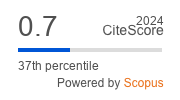Etiology of Bloody Diarrhea among Children Admitted to Maternity and Children ’ s Hospital-Erbil
Keywords:
: Bloody diarrhea, etiology, Entamoeba histolyticaAbstract
Background: Bloody diarrhea plays a major role in
morbidity and mortality especially in developing
countries, it is usually a sign of invasive enteric
infection, there is a thought that amoebic dysentery is
more common than bacillary dysentery in Iraq, and
from 1989 to 1997 amoebic dysentery increase from
20000to 550000 patients.
Objectives: This study aims to:
1. Outline the incidence of various infectious causes of
bloody diarrhea in Erbil district.
2. Assess the effect of multiple factors like age, sex,
source of water supply, etc... On the incidence of
amebic and bacillary dysentery.
3. To provide baseline data for making strategic plan to
reduce the diarrhoeal mortality and morbidity.
Methods: A prospective case- series study was
conducted on 116 infants and children aged 2 month –
12 years admitted to hospital complaining of bloody
diarrhea. Information was taken from their mothers
regarding (age, sex, geographical area, feeding pattern
and source of water supply) , their stool have been
examined for the presence of RBC, leukocyte, parasitic
cyst and trophozoit, however blood examination was
conducted for the presence of band.
Results: The results reveal 77.5% of patients were in the
younger age group (<2 year). Entamoeba histolytica was
the most common enteropathogen isolated in 60.3% of
patients, other enteropathogens identified were Shigella
3.5%, E.coli2.6%, Salmonella2.6%, mixed infection
were reported in 1.72%, 28.5%of patients have non
isolated pathogen.
On the other hand, source of water supply and type of
feeding have significant effect on incidence of
enteropathogens. The presence of fever, vomiting,
convulsion and band in peripheral blood mostly
indicates bacterial etiology.
Conclusion: Entamoeba histolytica was the commonest
enteropathogen isolated; the incidence of bloody
diarrhea was more in younger age group. There was
significant effect of source of water supply on the
incidence of bloody diarrhea with most enteropathogen
isolated from patients who have well water supply.
Breastfeeding was protective against enteropathogen
especially bacterial agents in infants under 6 month of
age. Presence of band in the peripheral blood indicates
most probably bacterial agents













